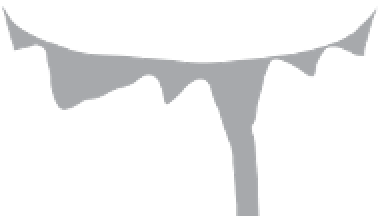Geology Reference
In-Depth Information
Caldera
Volcano (Wizard Island)
Figure 5.8
Crater Lake caldera, Oregon, USA.
Source:
Adapted from MacDonald (1972, 301)
calderas between 22 million and 30 million years old.
Ignimbrites from these calderas cover 25,000 km
2
.
down established valleys. Erosion then reduces the adja-
cent hillside leaving the more resistant volcanic rock as a
ridge between two valleys. Such inverted relief is remark-
ably common (Pain and Ollier 1995). On Eigg, a small
Hebridean island in Scotland, a Tertiary rhyolite lava
flow originally filled a river valley eroded into older basalt
lavas. The rhyolite is now preserved on the Scuir of Eigg,
an imposing 400-m-high and 5-km-long ridge standing
well above the existing valleys.
Indirect effects of volcanoes
Volcanoes have several indirect impacts on landforms.
Two important effects are
drainage modification
and
relief inversion
.
Radial drainage patterns often develop on volca-
noes, and the pattern may last well after the volcano
has been eroded. In addition, volcanoes bury pre-
existing landscapes under lava and, in doing so, may
radically alter the drainage patterns. A good example
is the diversion of the drainage in the central African
rift valley (Figure 5.10). Five million years ago, volca-
noes associated with the construction of the Virunga
Mountains impounded Lake Kivu. Formerly, drainage
was northward to join the Nile by way of Lake Albert
(Figure 5.10a). When stopped from flowing north-
wards by the Virunga Mountains, the waters eventually
overflowed Lake Kivu and spilled southwards at the
southern end of the rift through the Ruzizi River into
Lake Tanganyika (Figure 5.10b). From Lake Tanganyika,
the waters reached the River Congo through the River
Lukuga, and so were diverted from the Mediterranean
via the Nile to the Atlantic via the Congo (King 1942,
153-4).
Occasionally, lava flows set in train a sequence of events
that ultimately inverts the relief - valleys become hills
and hills become valleys (cf. p. 156). Lava tends to flow
IMPACT CRATERS
The remains of craters formed by the impact of asteroids,
meteoroids, and comets scar the Earth's surface. Over
170 craters and geological structures discovered so far
show strong signs of an impact origin (see Huggett 2006).
Admittedly, impact craters are relatively rare landforms,
but they are of interest.
In terms of morphology, terrestrial impact structures
are either simple or complex (Figure 5.11). Simple
structures, such as Brent crater in Ontario, Canada, are
bowl-shaped (Figure 5.11a). The rim area is uplifted and,
in the most recent cases, is surmounted by an overturned
flap of near-surface target rocks with inverted stratigra-
phy. Fallout ejecta commonly lie on the overturned flap.
Autochthonous target rock that is fractured and brec-
ciated marks the base of a simple crater. A lens of shocked
and unshocked allochthonous target rock partially fills
the true crater. Craters with diameters larger than about

















